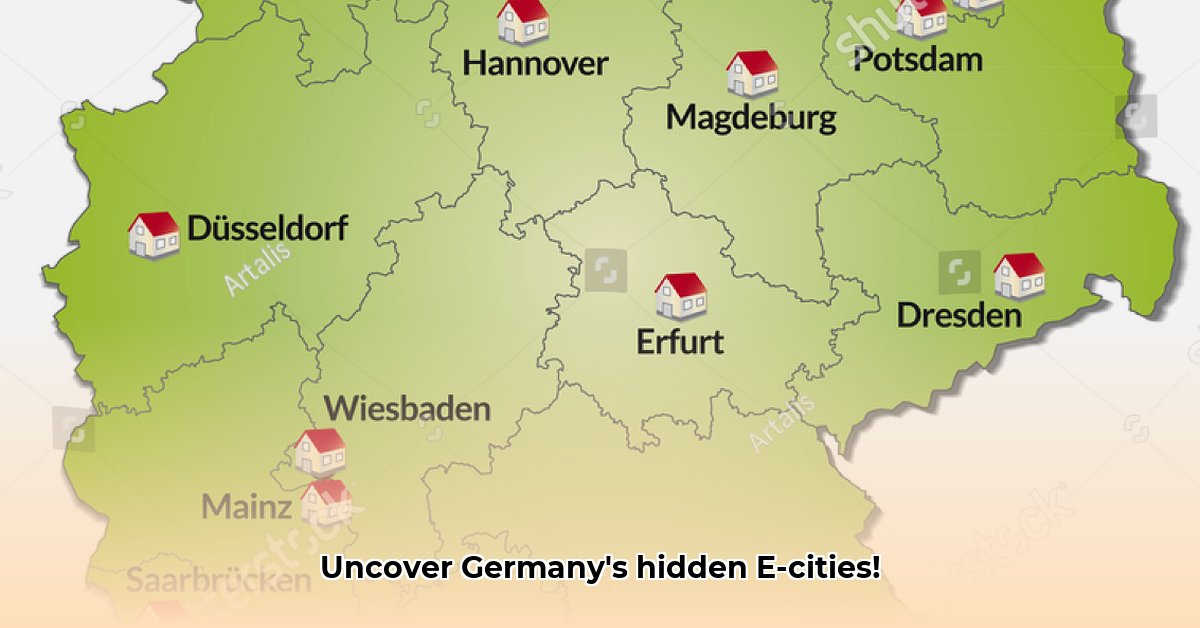Ready to explore Germany’s best-kept secrets? Let’s dive into the fascinating world of German cities starting with “E.” You might be surprised by how many there are – different sources cite various numbers, some claiming over 471! This variance arises from differing definitions of what constitutes a “city” versus a “town” in Germany. But don’t worry, we’ll navigate these inconsistencies together by exploring major cities, charming smaller towns, and historically significant locales. We’ll examine locations, unique characteristics, and clarify the mystery behind the varying city counts. For a comprehensive list, see this [helpful resource](https://theblaregroup.com/cities-that-start-with-e/). Get ready for an exciting journey through Germany’s diverse landscape!
Cities Starting with E in Germany: Unveiling European Gems
Germany boasts a wealth of captivating towns and cities, each with its own distinct story. Ever wondered how many of these settlements begin with the letter “E”? The answer is more complex than it seems! Different sources cite wildly different figures, making it challenging to arrive at a definitive count. This discrepancy stems from the varying definitions of a “city” in Germany. Some locales might be recognized as a “city” in one database while classified as a “town” in another. This ambiguity only adds to the thrill of discovery as we explore Germany’s diverse landscape!
Major Cities: Urban Centers and Landmarks
Let’s begin with the prominent players—the major cities that start with “E”:
-
Erfurt: As the capital of Thuringia, Erfurt exudes charm. Wander through its well-preserved medieval old town, marvel at the magnificent Erfurt Cathedral, and immerse yourself in its vibrant cultural scene. Erfurt offers a wealth of historical sites and architectural treasures.
-
Eisenach: Located in Thuringia, Eisenach is renowned for the iconic Wartburg Castle, a UNESCO World Heritage site of immense historical significance. Beyond the castle, Eisenach offers a mesmerizing blend of history, culture, and natural beauty, making it a must-visit destination.
-
Eberswalde: Situated in Brandenburg, Eberswalde presents a unique blend of natural beauty and industrial heritage. Surrounded by lush forests and traversed by canals, the city offers a refreshing departure from traditional historical towns.
-
Emden: For a glimpse into Germany’s maritime past, Emden in Lower Saxony beckons. As a major port city, Emden showcases Germany’s connection to the sea, offering a fascinating journey for those intrigued by seafaring and trade.
Exploring Germany by State: A Geographic Overview
To appreciate the distribution of these “E” cities, let’s organize them by German state (Bundesland), providing a clearer understanding of their locations:
| State (Bundesland) | Example Cities | What Makes It Special? |
|---|---|---|
| Brandenburg | Eberswalde, Eisenhüttenstadt | Blending nature and industry, offering a distinctive perspective; Eisenhüttenstadt showcases post-war architecture. |
| Thuringia | Erfurt, Eisenach | Steeped in history, boasting stunning architecture and cultural richness; Eisenach is home to the UNESCO World Heritage Wartburg castle. |
| Lower Saxony | Emden, Esens | Coastal charm and historical significance blend seamlessly; Emden features a bustling port, while Esens provides a glimpse into traditional East Frisian culture. |
| Bavaria | Ebern, Eichstätt | Picturesque towns showcase unique architectural styles and local traditions; Eichstätt houses notable baroque architecture. |
| North Rhine-Westphalia | Essen, Erkelenz | Industrial heritage meets modern city life, a dynamic contrast; Essen is a major industrial hub while Erkelenz features a historic market square. |
| Baden-Württemberg | Ehningen, Emmendingen | Picturesque towns nestled in the heart of Germany’s scenic regions; Emmendingen is known for its proximity to vineyards and the Black Forest. |
| Rhineland-Palatinate | Edenkoben, Eich | Wine-growing traditions and scenic landscapes; Edenkoben is popular for wine festivals, while Eich boasts a historic church. |
| Saxony | Eilenburg, Ehrenfriedersdorf | Towns with rich medieval history; Eilenburg features historic churches, Ehrenfriedersdorf is nestled in the Ore Mountains. |
| Schleswig-Holstein | Eckernförde, Elmshorn | Coastal towns with maritime character; Eckernförde is a seaside resort, while Elmshorn offers proximity to Hamburg. |
| and many more… | … | Germany’s rich diversity guarantees the existence of numerous other towns and cities! |
(Note: This is not an exhaustive list. The number of cities starting with “E” is approximate due to variations in how “city” is defined.)
Historical Gems: Echoes of the Past
Some of these cities hold significant historical importance:
-
Eisenach’s Wartburg Castle: A UNESCO World Heritage site, this castle witnessed Martin Luther’s translation of the Bible. It also nurtured the Minnesingers, medieval poets and musicians, offering an immersive historical experience.
-
Erfurt’s Krämerbrücke: This iconic bridge, adorned with shops and residences, exemplifies medieval architecture, symbolizing Erfurt’s rich heritage, making it a must-see for photographers and history enthusiasts.
Beyond the Major Cities: Hidden Charms
Beyond the well-known cities, discover numerous smaller towns and villages that contribute to Germany’s unique identity. These often feature quaint local traditions and breathtaking natural scenery. Explore cobblestone streets, half-timbered houses, and a slower pace of life, unveiling the authentic charm of Germany beyond the bustling city centers.
The Elusive Number: Data Challenges
Obtaining a precise count of German cities beginning with “E” proves challenging due to varying definitions of “city” (Stadt) versus “town” (Gemeinde) compounded by Germany’s federal structure. Each state classifies settlements differently, leading to inconsistencies across databases. This complexity adds to the intrigue of exploration!
Your Next Adventure: Further Exploration
Intrigued? Continue your journey by exploring individual state tourism websites for detailed information. Delve into local archives and historical societies to uncover unique histories and cultures. Germany’s towns and cities await discovery. Pack your bags – adventure beckons!
How to Reconcile Discrepancies in German City Databases Starting with E
Have you noticed varying numbers of German cities from different sources, especially those starting with “E?” This results from the complex history and evolving definitions of urban settlements in Germany. Let’s navigate this challenge.
Categorizing German Cities Starting with “E” for Data Clarity
To reconcile discrepancies in German city databases starting with “E,” employ a structured approach. Instead of aiming for a definitive list, categorize cities to manage inherent data uncertainties.
- Major Cities (Population > 100,000): Prominent cities like Essen and Erfurt are easily identified.
- Cities by State (Bundesland): Grouping cities by state (Bavaria, Baden-Württemberg, etc.) provides regional context reflecting uneven population distribution since each state has its own record-keeping.
- Historically Significant Cities: Small towns with historical importance influence their classification across databases.
- Smaller Towns and Villages: Exhaustive data is challenging, so focus on representative examples.
Delving into Discrepancies and Data Definition
Inconsistent numbers stem from:
- Shifting Definitions: Changing definitions of “city” (Stadt) versus “town” (Markt, Gemeinde) impact historical data.
- Data Collection Methods: Varying methods across databases lead to inconsistencies depending on population counts or administrative classifications.
- Data Updates: Constant population shifts and administrative changes create a dynamic city landscape with perfect synchronization across all sources a challenge.
Strategies for Reconciliation and Data Strategy
To reconcile discrepancies in German city databases starting with “E,” use this approach:
- Identify Sources: Understand data source strengths and weaknesses utilizing official government records, statistical bureaus, and historical town archives.
- Define Parameters: Clearly define “city” for research based on size and importance metrics.
- Cross-Reference Data: Compare data across multiple databases to identify overlaps and inconsistencies for a more accurate picture.
- Prioritize Historical Context: Consider a city’s historical evolution and significance to understand its current classification.
- Exotic Feminine Names with Beautiful Meanings and Global Origins - December 12, 2025
- Exotic Girl Names Reflecting Diverse Cultures And Unique Beauty - December 11, 2025
- Exotic Female Names Offer Cultural Richness and Unique Sounds - December 10, 2025










